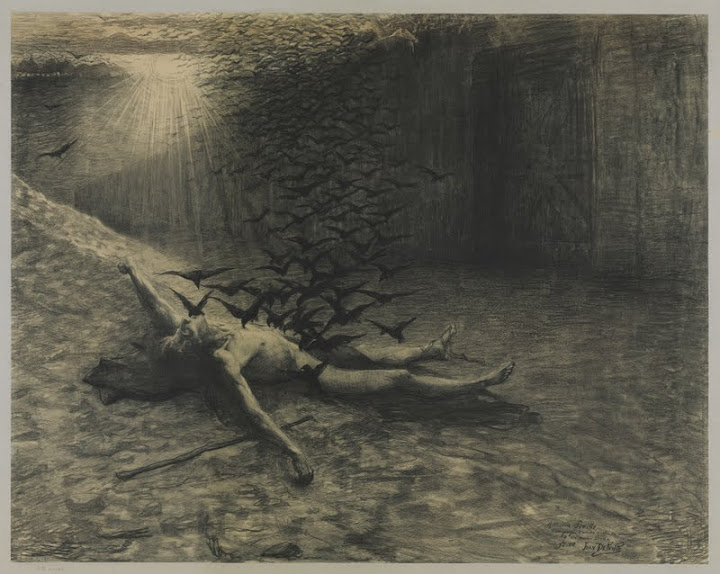Unknown work of Delville discovered

Exclusive news for the Royal Library and the Fin-de-Siècle Museum: an until recently unknown artwork of Jean Delville has been (re)discovered in the collections of the Royal Library’s Prints Cabinet. As a privileged partner of the Royal Museums of Fine Arts of Belgium, the Library is exhibiting this rare discovery at the Fin-de-Siècle Museum.
Exclusive news for the Royal Library and the Fin-de-Siècle Museum: an until recently unknown artwork of Jean Delville has been (re)discovered in the collections of the Royal Library’s Prints Cabinet. As a privileged partner of the Royal Museums of Fine Arts of Belgium, the Library is exhibiting this rare discovery at the Fin-de-Siècle Museum.
Too large to be noticed
The drawing by Jean Delville, dating back to 1888, was found in the collections of the Royal Library’s Prints Cabinet during a research conducted for the Fin-de-Siècle Museum. Oddly enough, it is its non-standard size (Atlantico, 98 by 118 cm) that allowed it to escape any classification until now.
Finally, the “drawing dedicated to the writer Maurice Siville” was discovered by systematically scanning the collections, not via the ordinary work files, but by looking at each format under Delville’s name.

Jean Delville, Dessin dédicacé à Maurice Siville à l’occasion de la parution de son livre « Contes pour l’aimée », 1888, fusain sur papier, KBR, Cabinet des Estampes, inv. S.III 41961 © SABAM Belgium
The artist
Jean Delville (1867-1953) was a painter, writer, poet and idealist. His works and writings aspire to be spiritual and symbolize a type of quest for the afterlife, for the meaning behind the invisible and for the ideal. The occult philosophy of Sâr Joséphin Péladan (1858-1918) and his Order of the Rose-Croix greatly influenced him.
Drawing holds a special place in Delville’s oeuvre: enhanced and made with grease pencils, pastel and gouache or single-coloured pencils. His technique is always well- thought-out and very researched; he seeks to follow the tradition of the disegno. This term does not only refer to drawing in the strict sense, but also to the idea, the concept behind a work.
The found work
The image itself is probably a representation of the Greek hero Orpheus’s death or a first figuration of Prometheus, whose liver was ripped out daily by an eagle. Delville was maybe also inspired by the myth of the Stymphalian birds who feed themselves on human flesh.
This is clearly an example of a recurring tendency in Delville’s work: integrating the irrational forces of myths in order to confer a sacred meaning.

Jean Delville, Orphée mort, 1893, huile sur toile (rentoilée), MRBAB, Bruxelles, inv. 12209 © SABAM Belgium /photo : J. Geleyns / Ro scan (œuvre actuellement prêtée au Palazzo Reale, Milan)
Origin
The work is dedicated to Maurice Siville, an art critic and influencing editor of “La Wallonie” and “Caprice-Revue”, an extremely popular weekly magazine for young and aspiring artists. In 1888, Siville publishes his “Tales for the beloved”. On this occasion, Delville dedicates a drawing to him as a testimony of their friendship. We know that shortly thereafter, Delville painted the Portrait of Madame Siville which was shown at the 14th exhibition of “L’essor” in 1890.
This work of Delville was directly given to the Prints Cabinet by the art critic’s widow herself and stayed hidden in those collections until its discovery a few months ago.
The Fin-de-Siècle Museum
Each semester, the Fin-de-Siècle Museum organizes a new exhibition which reflects the richness of the art world around the 1900s. These collection “rotations” allow them to show the public fragile – and therefore rarely exhibited – works from famous names such as Rops, Degas, Renoir, Gauguin, Van Gogh, Signac, Munch and Toulouse- Lautrec, etc. Major partners help keeping the rotations dynamic and further illustrate the multidisciplinary nature of the represented time: the Royal Library, the Royal Theatre of la Monnaie, the Royal Museums of Art and History, the Cinematek, Bibliotheca Wittockiana, the King Baudouin Foundation, the Royal Conservatory of Brussels, Belfius and, for the deposit of the extraordinary Gillion-Crowet collection, the Brussels Capital Region.
The Prints Cabinet of the Royal Library
With over 1.000.000 documents to be studied, the employees of the Prints Cabinet regularly discover exceptional pieces in the collections assembled over many years in the Royal Library. These collections enjoy a particularly careful approach thanks to the Alvinus project, aimed at digitizing the collections as well as making them available online.

